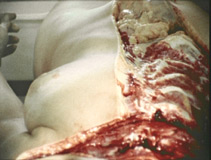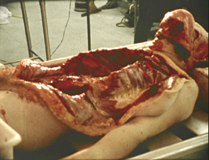|
Newest Reviews:
New Movies -
The Tunnel
V/H/S
The Tall Man
Mama Africa
Detention
Brake
Ted
Tomboy
Brownian Movement
Last Ride
[Rec]³: Genesis
Hara-Kiri: Death of a Samurai
Indie Game: The Movie
Abraham Lincoln: Vampire Hunter
Old Movies -
Touki Bouki: The Journey of the Hyena
Drums Along the Mohawk
The Chase
The Heiress
Show
People
The Strange Affair of Uncle Harry
Pitfall
Driftwood
Miracle Mile
The Great Flamarion
Dark Habits
Archives -
Recap: 2000,
2001, 2002,
2003, 2004
, 2005, 2006,
2007 , 2008
, 2009 ,
2010 , 2011 ,
2012
All reviews alphabetically
All reviews by star rating
All reviews by release year
Masterpieces
Screening Log
Links
FAQ
E-mail me
HOME
| |
The Act of Seeing with One’s Own Eyes (Stan Brakhage,
1971)
 Offering what is probably the longest
uncomfortable silence in the history of cinema, Stan Brakhage’s documentary
short The Act of Seeing with One’s Own
Eyes is a harrowing, unshakable, but fundamentally fascinating, viewing
experience. Set entirely in a Pittsburgh morgue, the film records three actual
autopsies with an unflinching eye. In its willingness to stare death and our
inescapably corporeal state in the face it practically begs the viewer to have
an extreme reaction. Different viewers, with different levels of squeamishness,
will respond differently to the material. For many, I imagine it is nigh-unwatchable.
Personally, I’ve seen several autopsy videos before (both in exploitation
films like the Faces of Death series
and in tapes produced for educational purposes), but I still found viewing this
movie a difficult experience and one that forced me to call into question
whether the illumination that I got from examining Brakhage’s approach was
worth the trauma of watching the movie. Because Act
of Seeing is entirely silent and because Brakhage’s roving camera does
more than passively observe the flaying of peoples’ bodies, it feels more
immediate than any such film I’ve seen before. He zooms his lens in to get
uncomfortably close to his subjects, turning flesh into an abstraction. In doing
so prompts the audience both to see the beauty there that we might otherwise
neglect and confront the fears that we’re able to avoid due to lack of
proximity to awareness of internal selves. Offering what is probably the longest
uncomfortable silence in the history of cinema, Stan Brakhage’s documentary
short The Act of Seeing with One’s Own
Eyes is a harrowing, unshakable, but fundamentally fascinating, viewing
experience. Set entirely in a Pittsburgh morgue, the film records three actual
autopsies with an unflinching eye. In its willingness to stare death and our
inescapably corporeal state in the face it practically begs the viewer to have
an extreme reaction. Different viewers, with different levels of squeamishness,
will respond differently to the material. For many, I imagine it is nigh-unwatchable.
Personally, I’ve seen several autopsy videos before (both in exploitation
films like the Faces of Death series
and in tapes produced for educational purposes), but I still found viewing this
movie a difficult experience and one that forced me to call into question
whether the illumination that I got from examining Brakhage’s approach was
worth the trauma of watching the movie. Because Act
of Seeing is entirely silent and because Brakhage’s roving camera does
more than passively observe the flaying of peoples’ bodies, it feels more
immediate than any such film I’ve seen before. He zooms his lens in to get
uncomfortably close to his subjects, turning flesh into an abstraction. In doing
so prompts the audience both to see the beauty there that we might otherwise
neglect and confront the fears that we’re able to avoid due to lack of
proximity to awareness of internal selves.
 Apparently one of the conditions of the
morgue’s cooperation in filming was the stipulation that Brakhage couldn’t
show enough of the faces of the corpses so that they could be recognized. Not
being able to put a face to the bodies that are mutilated does lessen the shock
of watching the film, somewhat, but at the same time, it renders them anonymous
enough that they can’t be as easily defined as “other people”. What’s
probably the biggest shock, and the film’s primary point, comes near the end.
Brakhage shows a janitor nonchalantly cleaning up after the procedure and then
watches as one of the coroners dictates his report into a microphone. His
complete professionalism in that context will strike the vast majority of
viewers as a totally foreign attitude, but the presence of his differing point
of view is as instructive as anything we’ve seen before. Both as a most
disturbing slice of vérité cinema and an examination of point of view,
Brakhage’s film challenges the viewer to reconsider the way that they think
about themselves. His insistent point of view doesn’t impose a point of view
upon the audience, but instead offers contradictions so that any easy answers
prove unsatisfactory. In adding a literal deconstruction of man to the
metaphorical one that graces so many works of art, Brakhage has created with The
Act of Seeing With One Eye the ultimate horror film, for better or worse. Apparently one of the conditions of the
morgue’s cooperation in filming was the stipulation that Brakhage couldn’t
show enough of the faces of the corpses so that they could be recognized. Not
being able to put a face to the bodies that are mutilated does lessen the shock
of watching the film, somewhat, but at the same time, it renders them anonymous
enough that they can’t be as easily defined as “other people”. What’s
probably the biggest shock, and the film’s primary point, comes near the end.
Brakhage shows a janitor nonchalantly cleaning up after the procedure and then
watches as one of the coroners dictates his report into a microphone. His
complete professionalism in that context will strike the vast majority of
viewers as a totally foreign attitude, but the presence of his differing point
of view is as instructive as anything we’ve seen before. Both as a most
disturbing slice of vérité cinema and an examination of point of view,
Brakhage’s film challenges the viewer to reconsider the way that they think
about themselves. His insistent point of view doesn’t impose a point of view
upon the audience, but instead offers contradictions so that any easy answers
prove unsatisfactory. In adding a literal deconstruction of man to the
metaphorical one that graces so many works of art, Brakhage has created with The
Act of Seeing With One Eye the ultimate horror film, for better or worse.
50
06-29-03
Jeremy Heilman
|